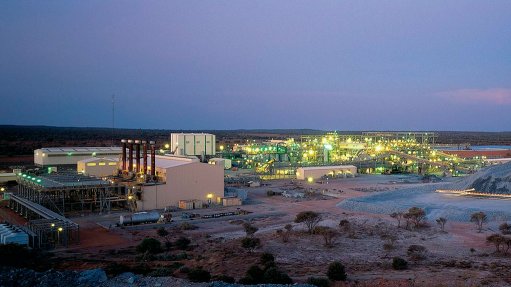South Africa’s mining sector a ‘sunrise industry’ – Motlanthe
TORONTO (miningweekly.com) – Despite some of South Africa’s mining sector critics pointing out the negatives, South African Deputy President Kgalema Motlanthe, who is on an official State visit to Canada, on Tuesday endeavoured to foreground the positives, saying a lot of progress had been made in transforming the sector from a “sunset business” into a “sunrise industry”.
Flanked by South Africa’s Labour Minister Mildred Oliphant and Mineral Resources Deputy Minister Godfrey Oliphant, Motlanthe – in an interview with Mining Weekly Online in Toronto – said South Africa was indeed ready and open for business, citing the achievements of almost 20 years of democracy having helped to transform archaic industry practices, which had been designed to benefit employers at the expense of the poor.
“While some people would want to say that South Africa’s mining industry is a sunset industry, it’s in fact a sunrise industry,” he said.
Mining remains central to the South African economy. Motlanthe affirmed that the industry was still the country’s most significant currency earner and despite more than a century of intensive exploitation, the industry was but turning over a fresh leaf and poised for significant growth, boosted by newly overhauled mining legislation dealing with inefficiencies, and by lifting domestic beneficiation levels.
As of 2007, the South African mining industry employed 493 000 workers and the industry represented about 18% of South Africa's $588-billion gross domestic product (GDP). Despite mining's contribution to the national GDP - which Goldman Sachs had found to have expanded by more than two-and-a-half times in the last twenty years - having fallen from 21% in 1970, to 6% in 2011, it still represented about 60% of all exports.
However, South Africa was in August ranked sixty-fourth out of 97 jurisdictions by Canada-based Fraser with regard to its competitiveness, and had a policy potential index of 35%. By comparison Botswana, ranked seveteenth, with a policy potential index of 78.1%.
Motlanthe noted that there were lots of proven deposits that were still to be exploited. South Africa’s mining industry is often wrongfully measured by the performance of the gold sector, and yet other subsectors such as iron-ore, diamonds, manganese, platinum and chrome were overlooked, he argued.
ENHANCED LEGISLATION
Motlanthe said Canadian investors and mining industry participants were most interested in asking the high-level delegation about issues surrounding the labour relations framework, energy supply to the mining industry, and about issues regarding the Mineral and Petroleum Resources Development Act (MPRDA), which was currently being amended.
The amended MPRDA would also overhaul the licensing processes so that companies applied for mining licences at a single office, with the water use licence and the environmental-impact assessments processed simultaneously. “That would result in shortening the turnaround time for juniors significantly. In the past it was done sequentially and, therefore, took much longer,” he noted.
Motlanthe also said that work was currently under way to improve the mining industry’s competitiveness within the global arena, conceding that there was only limited scope for improvement within the country’s deep, aging gold mines.
“Some of our gold mines are more than 4 km deep, and it takes workers a significant time to commute between the shafts and the work face. This impedes the industry’s productivity,” he said.
Motlanthe said Parliament was currently processing a Bill that would create a new entity that would take over control of the country’s electricity transmission network, which should make it easier for private power producer (IPP) projects to be integrated into the national grid.
State-owned electricity generation, reticulation and distribution company Eskom, was currently also in control of the national grid, and IPPs were concerned that Eskom was simultaneously a competitor while controlling access to the grid.
“Once the concern was raised, government understood that indeed the national grid should be placed under the control of an independent body. This would benefit many of the mining houses, which have the capacity to produce power independently, especially in the platinum sector, where they are increasingly getting involved with renewable energy and the innovation of the hydrogen fuel cell,” he said.
The Deputy President further said that he had found a lot of goodwill and eagerness about the South African mining industry among current and prospective industry participants.
Motlanthe was optimistic about using existing and new platinum operations - such as entrepreneur and mining legend Robert Friedland’s significant Platreef project, which was currently being proven up by Ivanhoe Mines - as a potential platform to create a ‘Platinum Valley’ in the platinum-rich Limpopo province, which would be as synonymous with hydrogen fuel cell manufacturing as California’s Silicon Valley is with technology.
“We’ll see whether that could be used as a platform to create much bigger things. The amendments to the [MPRDA] are meant to actually guarantee a dependable supply to local manufacturers, at beneficial costs,” he said.
CHANGING LABOUR LANDSCAPE
The Deputy President also pointed out that much progress had been made with transforming the mining labour landscape.
“At the moment, we are involved with an all inclusive dialogue, a framework crafted and agreed to by all stakeholders, including organised labour, businesses, affiliated mining houses and government, through which we look at the whole range of archaic practices that serve as irritants today – methods that were previously used to serve the industry very well in terms of securing cheap labour. We are looking at changing all of this,” he said.
He noted that a consensus had now been reached as to how these old practices should be addressed and done away with.
Motlanthe pointed to the example of many mine workers being compelled to leave their families for significant periods of time, to live in same-sex mine compounds.
“We are encouraging mines to look into implementing a shorter six-month work cycle, to allow miners to return home more frequently. That is still a work in progress, but we think it will remove many of the social deterrents and irritants of the mining industry,” he said.
Speaking about the regular international reports of labour unrest within the mining industry, Motlanthe said the disputes were mainly between employers and employees, but added that government was endeavouring to bring all parties together to find ways to manage the relationship within the scope of the Labour Relations Act.
MEDIA TO BLAME
Motlanthe also fingered the media in its often-selective reporting on the South African mining industry.
He bemoaned the country’s negative international perception, saying it was created by the media reporting only “three-second sound bites” that gave no context.
“People don’t get to know about the real causes of the disputes. Our responsibility is to provide the information factually to all interested parties to ensure that there is an understanding of the full picture of what the causes are.
“Because of intervention, we have made lots of progress, but as it were, we are not receiving any coverage on that. The situation in South Africa is of course now stable, and we are working on maintaining that. That is not receiving any coverage,” he said.
Motlanthe concluded: “We have political and labour stability and the South African mining industry is a sunrise industry. This is because investments are protected and returns are guaranteed.”
Comments
Press Office
Announcements
What's On
Subscribe to improve your user experience...
Option 1 (equivalent of R125 a month):
Receive a weekly copy of Creamer Media's Engineering News & Mining Weekly magazine
(print copy for those in South Africa and e-magazine for those outside of South Africa)
Receive daily email newsletters
Access to full search results
Access archive of magazine back copies
Access to Projects in Progress
Access to ONE Research Report of your choice in PDF format
Option 2 (equivalent of R375 a month):
All benefits from Option 1
PLUS
Access to Creamer Media's Research Channel Africa for ALL Research Reports, in PDF format, on various industrial and mining sectors
including Electricity; Water; Energy Transition; Hydrogen; Roads, Rail and Ports; Coal; Gold; Platinum; Battery Metals; etc.
Already a subscriber?
Forgotten your password?
Receive weekly copy of Creamer Media's Engineering News & Mining Weekly magazine (print copy for those in South Africa and e-magazine for those outside of South Africa)
➕
Recieve daily email newsletters
➕
Access to full search results
➕
Access archive of magazine back copies
➕
Access to Projects in Progress
➕
Access to ONE Research Report of your choice in PDF format
RESEARCH CHANNEL AFRICA
R4500 (equivalent of R375 a month)
SUBSCRIBEAll benefits from Option 1
➕
Access to Creamer Media's Research Channel Africa for ALL Research Reports on various industrial and mining sectors, in PDF format, including on:
Electricity
➕
Water
➕
Energy Transition
➕
Hydrogen
➕
Roads, Rail and Ports
➕
Coal
➕
Gold
➕
Platinum
➕
Battery Metals
➕
etc.
Receive all benefits from Option 1 or Option 2 delivered to numerous people at your company
➕
Multiple User names and Passwords for simultaneous log-ins
➕
Intranet integration access to all in your organisation





















